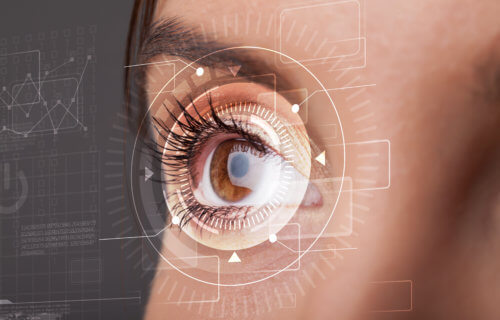
AMSTERDAM, Netherlands — A blind woman, living without her vision for 16 years, now has the ability to see shapes again thanks to a revolutionary brain implant. An international team says this groundbreaking procedure has created a form of “artificial vision” by stimulating neurons in the brain.
Researchers from Spain, the Netherlands, and the United States implanted a microelectrode array containing 100 microneedles into the visual cortex of the 58-year-old patient. The electrodes recorded activity from and stimulated the neurons around this implant.
From there, the woman wore eyeglasses with a built-in miniature video camera that picked up the visual signals from specialized software. The data then went to the electrodes in the patient’s brain where the stimulated neurons could produce white points of lights called phosphenes — creating an image.
Paving the way for a visual prosthesis
The patient, a former science teacher, lost her sight 16 years ago. With the help of the implant, she can now distinguish between lines, shapes, and simple letters during simulations.
Moreover, the patient did not have any post-surgery complications and the team did not note any impairments or negative impacts in brain functioning. To practice using the prosthesis, the team created a video game featuring a character from “The Simpsons” for the 58-year-old to use.
“These results are very exciting because they demonstrate both safety and efficacy and could help to achieve a long-held dream of many scientists, which is the transfer information from the outside world directly to the visual cortex of blind individuals, thereby restoring a rudimentary form of sight,” says Professor Eduardo Fernández of University Miguel Hernández in a university release. “Although these preliminary results are very encouraging, we should be aware that there are still a number of important unanswered questions and that many problems have to be solved before a cortical visual prosthesis can be considered a viable clinical therapy.”
“This new study provides proof-of-principle and demonstrate that our previous findings in monkey experiments can be translated to humans,” adds study co-author Prof. P. Roelfsema. “This work is likely to become a milestone for the development of new technologies that could transform the treatment of blindness.”
“One goal of this research is to give a blind person more mobility,” co-author Prof. R. A. Normann concludes. “It could allow them to identify a person, doorways, or cars. It could increase independence and safety. That’s what we’re working toward.”
Study authors are now hoping to create an even more sophisticated encoding system that will create more complex images for the blind.
The study appears in The Journal of Clinical Investigation.
